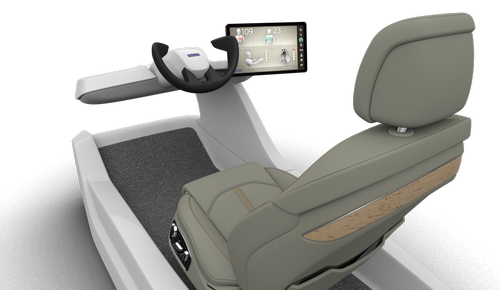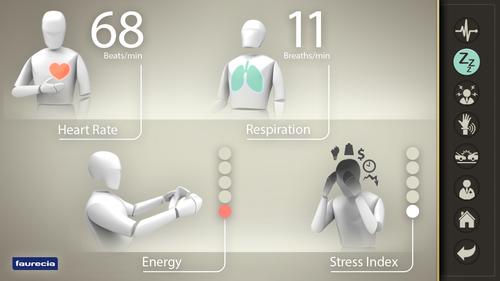Automotive ‘Wellness Seat’ Aids Stressed Out Drivers
A new sensor-equipped automotive seat could make drivers happier, more comfortable and more alert.
July 8, 2016
Known as the Faurecia Active Wellness Seat and expected to hit the road as soon as 2019, the chair uses sensors, ventilation materials, and pneumatic pumps to cool drivers off and, if necessary, give them massages. “If you’re stuck in traffic and kind of stressed out, the seat can help calm you down,” said Jim Hotary, director of the XWorks Innovation Lab at Faurecia, a French automotive supplier.

Faurecia’s Active Wellness Seat can cool itself, provide ventilation, or give a message to the driver. (Source: Faurecia)
The product of multiple years of engineering effort, the Active Wellness Seat may be the biggest step forward in automotive seating since the lumbar support. It uses 16 piezoelectric sensors – eight in the seat cushion and eight more in the seat back – to determine the driver’s physical and emotional state. By “knowing” the driver’s heart rate and respiration, it can then work with a dedicated electronic control unit (ECU) to determine if the driver needs aid. If so, the ECU can command a pneumatic pump and 20 air bladders in the seat to provide the driver with a massage. It can also use Peltier devices to supply thermoelectric cooling to the seat. Cooling and ventilation is delivered through permeable “spacer fabrics,” rather than ducts, which transmit the cooled air.
Faurecia engineers say that the key to the system is its ability to comprehend the state of the occupants. The company’s engineers considered other types of sensors – including medical ECG sensors, pulse oximeters, and mmWave radar sensors – before settling on piezoelectric devices. The piezos employ a so-called “ballistocardiograph” technique, which enables the vehicle to monitor vibrations from the body and to recognize changes in pulse and respiration.
”If you know the driver is uncomfortable, only then can you do something about it,” Hotary told Design News. But use of the technique presented challenges, he added. ”It looks at the vibration or shift in the center of mass as a result of movement of the heart and flow of the blood,” Hotary explained. “But there are interactions that need to be understood. When you have a massage system moving inside the seat, it can look a lot like respiration. The software has to distinguish between the two.”
Faurecia believes the technology is emerging at the right time, given the speedy evolution of autonomous vehicles. The company says that the sensors would enable a car to “know” if a driver is alert when the time came for driving chores to transition from autonomous to human. “There’s going to be a real need for the vehicle to characterize what’s happening,” Hotary said. “It needs to know if the driver is sound asleep or reading a book.”
Faurecia said that several luxury car makers are expressing interest in the technology. Those companies could use the whole package of sensors, along with the ventilation and massage technology, or they could opt to use only the sensor technology, and then tie that in with other vehicle sub-systems.
”We’re seeing an overwhelming response right now,” Hotary said. “There are all kinds of reasons why the vehicle needs to know what’s going on with the driver.”
Click the image below to view more details of the Faurecia Active Wellness Seat

Using piezoelectric sensors, the Active Wellness Seat can measure the driver’s heart rate and respiration. (Source: Faurecia)
READ MORE ABOUT BICYCLES AT DESIGN NEWS:
Senior technical editor Chuck Murray has been writing about technology for 32 years. He joined Design News in 1987, and has covered electronics, automation, fluid power, and autos.
About the Author(s)
You May Also Like



